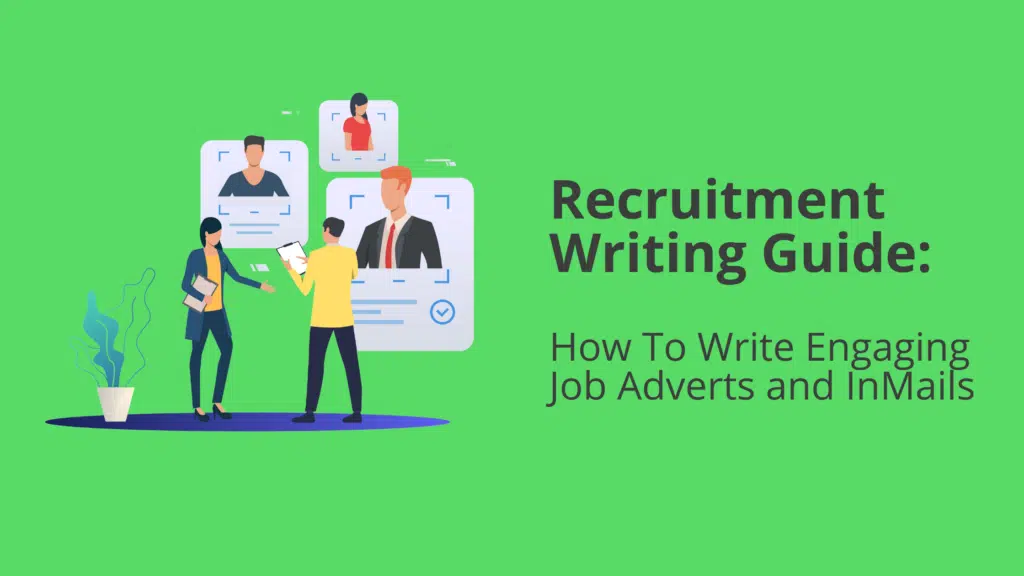This is a guide to copywriting for recruiters.
If you are looking for:
- More responses to your InMails
- Higher quality candidates through your job adverts
Then you’ll love the actionable tips in this guide.
Let’s jump right into it!
Chapter 1: What makes a good job advert?
Writing an engaging job advert can significantly reduce your time to hire, simply because you’ll be able to allocate your time to more relevant candidates. But what makes a good job advert?
1.1. A good job advert is candidate-centric
Communication style
Are your job adverts filled with phrases such as “We are looking for…” or “We would like the person to have this and this” or “We want you to start doing this and that.”
If yes, then you are focusing on what you need, rather than what you can offer to the candidate.
If you want to catch the attention of the best candidates, you need to focus on what’s in it for them.
For instance:
“We want the person to successfully manage social media accounts,” ❌
“In this role, you will have the opportunity to take our social media content to another level.” ✔️
It’s a little change, but makes a world of difference.
How will you support the candidate?
A candidate-centric job advert describes how the company will help the candidate to be successful in the role. Sure, you want the candidate to successfully meet sales targets, but will you provide them with sufficient training beforehand? Will they have a mentor in the company whom they can learn from? You have to show candidates that they’ll have a strong support system behind them.
Example:
“As a member of our sales team, it is important you work great under pressure and are able to meet deadlines. To help you reach your goals, we will provide training sessions and monthly seminars.”
Features into benefits
When Apple markets their new iPod, they don’t focus on the technical abilities of the device. What does “128GB of storage” mean to a potential buyer? Not much.
Instead, Apple takes the feature of their new device and turns it into a benefit, which can be used in their marketing message.
128GB of storage – that’s a feature.
1000 songs in your pocket – that’s a benefit.
Benefits-based copywriting is the cornerstone of any type of advertising. The same goes for job adverts. When candidates see your job advert, they must see the value in it. They want to know how their life will be better if they actually were to work in this position.
Benefits are NOT a monthly sports compensation, a company car, nor a competitive salary.
Benefits are emotional rewards.
An example can be given when you describe the job tasks. Let’s say you are writing a job description for a social media manager role. You can describe one of the job tasks as:
“Take ownership of the creation and output of content across all social media channels.”
That’s a feature of the job – something that the candidate will do. But instead, you can take the feature of the job advert and turn it into a benefit, saying:
“Create and execute a social media strategy to help a well-liked brand become a well-loved business.”
By doing this, you invite the candidate to already envision themselves making a big impact at the company.
Let’s look at another one:
“Design and build HR processes from scratch for a fast-growing start-up.” ❌
“Be the heart and soul of shaping the company culture of the next potential unicorn.” ✔️
You have to sell the role by always being one step ahead. The fact that the candidate will take over the design of the company’s HR processes doesn’t mean much. They are probably already doing it at their current job. But if you say to the candidate that they could be the main influencer of shaping a billion-dollar company’s culture, it makes it more persuasive and appealing.
1.2. Answers the questions “Who” and “Why”
Candidates are increasingly concerned about the impact they’ll have in their jobs. That means it is important you provide a short summary of “Who am I looking for?” and “Why is this position important?” in your job advert. If the candidates don’t understand the need for this position in your company, then they are likely not going to apply. So, provide a short description of why this role is important in your organization, as well as what kind of person you are looking for. Describe your successful candidate’s soft skills and hard skills.
1.3. Writes what candidates want to know
According to research, the five most common things candidates want in a job advert are: job tasks (59%), career path examples (36%), successful candidate profile (32%), benefits (30%), salary ranges (27%).
Furthermore, 47.7% of candidates will have had no previous relationship with or knowledge of your company. So, make sure you have a section where you introduce your company and its mission.
Besides the aforementioned things, candidates want to have a clear understanding of the company culture.
We recommend creating content about your existing employees which you can link to in your job advert. This content can be anything from blog posts, a day-in-the-life vlogs to short testimonials.
Here are examples of Google and Wise using employer branding content to attract new applicants.
1.4. Can be found on search engines
When writing a job advert, especially the title, you have to consider what candidates are searching for. Writing titles such as “Office Wizard” or “Marketing Guru” is fun, but it doesn’t help candidates to find your advert.
Instead, be as specific as possible. If you are looking for a sales manager to work with business clients across the globe, instead of writing “Sales Manager,” write “Global B2B Sales Manager.”
1.5. Allows candidates to skim-read.
Skim-reading isn’t something that people only do with job adverts. People like to skim-read every text. If your job advert doesn’t use headings or includes large chunks of text, you are going to lose the reader’s attention. It’s important you use plenty of whitespace to make your job advert text easy to read.
Here’s an example of how NOT to do it: ❌
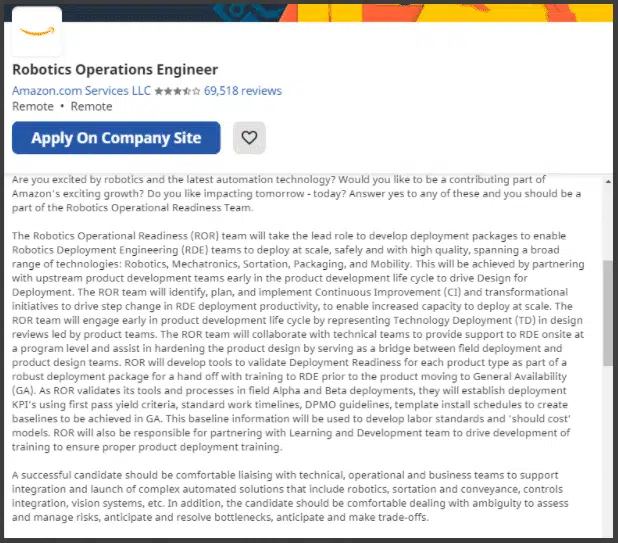
How likely are you going to read everything on this job advert? Not likely is my guess.
Here’s an example how to do it: ✔️
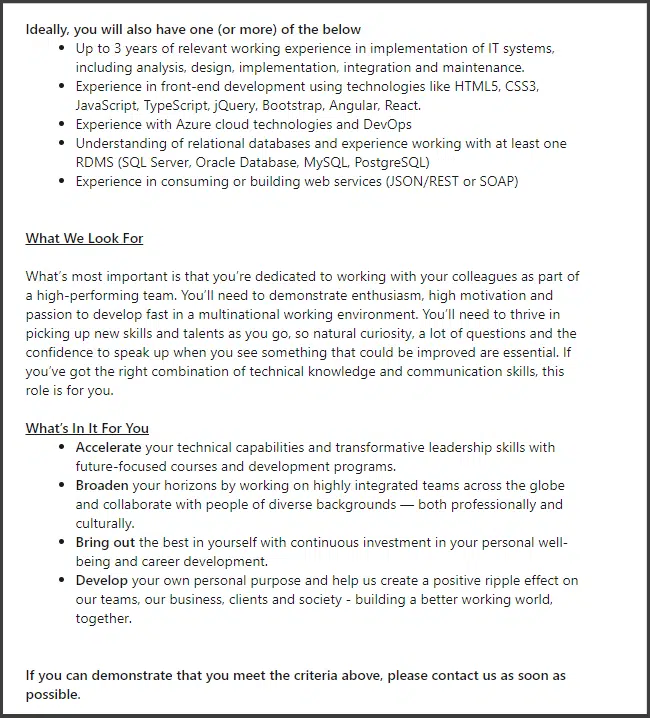
This job advert uses headings, which allows the text to be spread out, making it easier to read for the candidate.
Chapter 2: Reasons why job adverts don’t work
The average conversion rate for a job advert is 2%. That means out of every 100 people that see your job advert, only two apply. That’s quite low, isn’t it?
But why don’t job adverts work? What keeps candidates from applying?
There could be plenty of reasons behind it. Here are the main ones:
2.1. The job advert is vague
A low conversion rate might mean your job advert doesn’t have all the necessary information for candidates to apply. It might be unclear for the candidate what the role entails, what’s expected of them and what the company is about.
How to tackle the problem: Write what candidates want. Research shows that the five most common things candidates want in a job advert are: job tasks (59%), career path examples (36%), successful candidate profile (32%), benefits (30%), salary ranges (27%).
2.2. Candidates reject themselves before applying
Another reason candidates don’t apply is that they already reject themselves. Research shows that women apply for jobs when they’re 100% qualified, whereas men apply when they meet at least 60% of the requirements.
How to tackle the problem: When describing requirements for the role – use the “must-have vs nice-to-have” approach. Ask yourself, what are the qualities that a successful candidate absolutely must have? Keep it to a maximum of five requirements. Otherwise, you are risking losing good candidates.
2.3. Candidates don’t see the value in the job
When writing your job advert, you have to know what makes your candidates tick. Nowadays, a competitive salary and the opportunity to work remotely might not be things that make people change jobs. Yes, candidates might fit your criteria, but why would they change jobs if they can already do the same thing in their current position?
How to tackle the problem: When selling the role, think about your employee value proposition. If you don’t know it – start by asking your current employees why they are currently working at your company? Why did they join? What has made them stay? From there, you’ll get a better idea of what you can offer to candidates, as well as what you can write in your job advert.
2.4. Candidates haven’t updated their CV
The best candidates are passive job seekers, meaning they aren’t actively browsing job portals looking for new opportunities. So, unless your job offer is really appealing, their first instinct is that they don’t have the time to update their CVs, which keeps them from applying.
How to tackle the problem: In your job adverts, instead of asking candidates for their CVs, ask for their LinkedIn profile, which they are far more likely to update on a regular basis.
2.5. The job advert is just boring
Finally, the job advert could just be dull. There could be a lot of unnecessary text and it might be visually unappealing.
How to tackle the problem: Use free tools such as Canva to make your job adverts visually appealing, and Hemingway Editor to make your writing easy-to-read and engaging.
Job advert checklist ✔️
Now you know the aspects that make up for a good job advert, as well as why most job adverts don’t work.
Here’s a checklist of questions to follow when looking at a job advert:
- Is the job advert candidate-centric?
- Does the job advert distinguish must-have vs nice-to-have requirements?
- Does the job advert use the wording “You, Your, Yours” or “We, Us, Our?”
- Does the job advert describe how the company will support the candidate?
- Does the job advert outline the benefits of the role?
- Does the job advert answer questions “Who are we looking for?” and “Why is this role important?”
- Does the job advert introduce the company?
- Does the job advert use headings?
- Can the job advert be found on search engines?
- Does the job advert have a clear call-to-action?
Take a look at your last job advert and see if it checks the boxes.
Chapter 3: How To Write Engaging InMails
InMails, also known as reach out messages, are one of the best ways how to get a prospective candidate interested in a role. Let’s talk about how to write a good InMail message.
3.1. Consider the AIDA formula
AIDA stands for Attention, Interest, Desire, Action. It is a copywriting technique that works for landing pages, emails, InMails, blog post intros, video scripts and more.
Here’s a real life example of how to use the AIDA formula in In Mails.
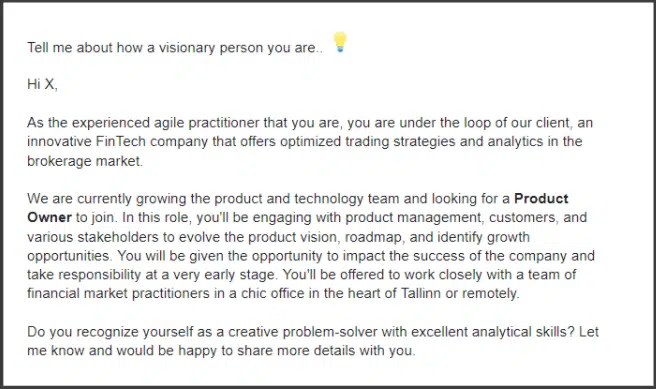
The subject line is unique and grabs the attention of the candidate.

Then, you spark their interest by telling them about the company.

Once you’ve grabbed the interest of your candidate, you have to make them desire the role by selling them the benefits.

Finish off with a call to action.

3.2. Personalisation is key
The key to a good reachout message is personalisation. Candidates can see through if you copy/paste the same text to everyone else.
To craft personalised messages, you first need to get to know your candidate. Have a thorough look at their LinkedIn profile and see if you can find anything worth mentioning about them. Perhaps you share some common connections with them. Or maybe you went to the same school. Also, check if they have published any content or articles which you might find interesting. Use this research to find something that you can point out in your reachout message. Show candidates that you have taken the time to get to know them past their job title.
3.3. Unique subject lines
The first thing that the candidate will notice about your InMail is your subject line. If your subject line does not catch the attention (remember AIDA?) of the candidate, they are most likely not going to open your message. That is how important a good subject line is.
Traditional subject lines such as “Opportunity at Company X” or “Product Manager Role at X” aren’t going to cut it.
I asked the TalentHub team about their most-used subject lines. Here they are:
- Do you believe intelligent autonomous systems are the future of security?🛸
- Refuse to be average. Aim to be great 💪🚀
- Do you balance the books OR the books balance you..? 😉
- Do you want to create a fierce product that is Lightyears ahead?⚡
- Java and coffee?☕
- This might be a longshot, but… 🤔
- We’re excited to build the future of (company name) with You!🚀
- Are you equipped with an innovator mindset?💡
- Skyrocket with (company name)!🚀
- Can I get your attention for a moment?👋
- Maybe another InMail/email/job offer/etc or – maybe opportunity of the lifetime🕵️
- Do you long to craft a brighter future for people across the world?
- Time for your next step, (first name)?🕵️
- Build a seamless society with us, (first name)!
- A cup of coffee?☕
- Ready to grab your passport to the metaverse?
- Greetings from TalentHub / Meeting with TalentHub (works if the brand is well-known)
- ((First name)) & TalentHub
- Product Manager at Estonia’s most beloved startup?
- Value creation on autopilot – Product Manager @ Pactum.
- You don’t want to miss THIS…
As you can see, these subject lines are far away from being traditional. You have to tap into your creative mind and think outside the box to get the attention of your candidates these days.
3.4. Put pressure on the candidate to respond
Your call-to-action should be specific and put pressure on the candidate to respond. Here’s an example.
“Let me know if this position interests you.” ❌
“Can I call you tomorrow to discuss this further with you?” ✔️
Again, it’s a small change that can make a big difference. If you give the candidate a timeframe, they are more likely to respond quicker. Otherwise, they might see the message and forget about it altogether.
3.5. Write less, say more.
Research shows that LinkedIn messages with less than 100 words tend to perform better, whilst those with more than 200 words get less responses.
I’m not saying you should follow the word count of your message. However, what this does mean is that you have to get your message across with as few words as possible.
Short sentences equals better copy.
Here’s an example:
“We are currently looking for highly experienced candidates. In order to apply, please send an email to johndoe@email.com along with your CV.”
This is 24 words. Can we cut it down without losing the message?
“We are looking for senior candidates. To apply, email your CV to johndoe@email.com.”
This is 13 words. The message stays the same with almost half as many words.
The key is to avoid fillers – words that are included in the sentence, but add no meaning to it.
Examples of filler words include:
Actually, very, seriously, totally, slightly, currently, really, highly, literally, perhaps, pretty, now, that, in order, some, just, maybe, kind of.
❌ Due to the fact —> Because
❌ In order to —> To
❌ Has the ability to —> Can
You get the idea.
Avoiding filler words and phrases makes your writing powerful.
Can you find any filler words in this InMail?

3.6. Write like your candidates talk
Writing good copy isn’t about coming up with the most clever messages. It’s about knowing where your prospects are, where they want to be, and how your solution helps them get there.
Job interviews and screenings are an opportunity for you to do market research.
If you interview dozens of software engineers, and they can’t stop talking about their motivation to build something impactful from scratch, then this is exactly what you need to mention in your InMails.
Or if you talk to graphic designers who say they hate being micromanaged in their current job, then you don’t base your InMail on the competitive salary the new role offers.
Another way to learn what candidates want is to look up studies. For instance, here’s a study by Stack Overflow, which found the top three job factors for software developers are the technologies they’d be working with (51.3%), company culture (44.5%) and flexible working times (43.9%).
Once you know what your candidates want, your InMails will make them say “This position is exactly for me.”
Candidate types – What type of candidates are you dealing with?
American psychologist William Moulton Marston proposed a powerful framework that describes the four main personality types of people.
Called DISC, the framework stands for Dominant, Influential, Steady, Calculating. Each personality type has different behavioral characteristics. Let’s have a look at what each personality type entails and how you can engage each type of person with your writing.
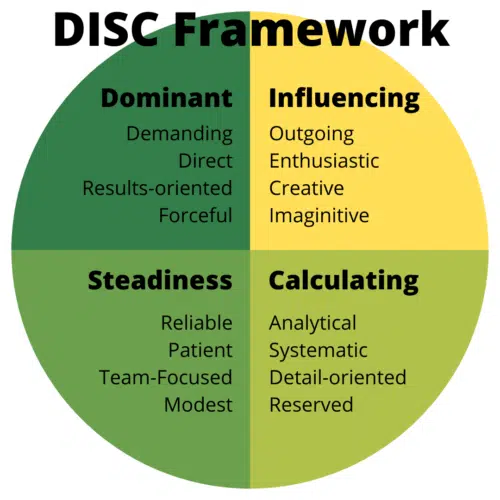
Dominant
The dominant personality types are focused on results. These people are demanding and direct in their feedback. They focus on the bigger picture and have no problem making big decisions. People with high levels of Dominant trait are likely to be found in leadership positions.
Examples of roles: Managers, CEOs, lawyers, strategic planners, sales managers
What should your InMail look like?
When trying to reach people with the dominant personality trait, you should base your message on facts:
What are the job tasks?
What does the company do?
What is the company’s vision?
What are the benefits of working at this company?
If you can, add a testimonial from a person of high status to your InMail.
Influential
People who are high in “I” are creative individuals. They are outgoing, energetic people who get inspiration from new ideas. Influential people put a lot of importance on their relationships.
Examples of roles: Marketers, advertisers, graphic designers, public relations specialists.
What should your InMail look like?
When recruiting the “I” types, you should give away as little details as possible, and leave room for imagination. Here’s when you can try some of your unconventional messages. Perhaps throw some humor in your message.
Steady
Individuals high in “S” are loyal, reliable people with a high work ethic. They crave structures and due to their dislike for change, they are more likely to be found in roles with a secure nature.
Examples of roles: Customer success, customer support, human resources manager, counselor.
What should your InMail look like?
Your reachout message to the Steady type should focus on the unchanging nature of the role you are filling. Don’t focus too much on facts and numbers, rather try to build a relationship with the person.
Calculating
People with the “C” personality type are detail-oriented. They value accuracy and value quality. Thanks to their ability to think deeply and analytically, they are naturally good problem solvers.
Examples of roles: Engineers, developers accountants, analysts
What should your InMail look like?
When selling a job role for a “C” personality type, you must focus your message on details. Your InMail should be in-depth with a lot of information, answering questions such as:
What are the job tasks?
What is the technology stack (if approaching engineers)?
What does the company do?
What is the vision of the company?
What is the company culture like?
Now it’s your turn!
I hope you enjoyed our guide to copywriting for recruiters.
What is the first tip that you will put into use?
Is it removing filler words from your writing?
Or hooking the candidate with an interesting subject line?
Leave a comment below!


